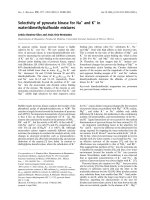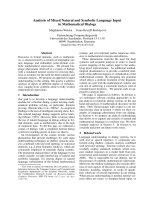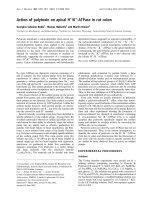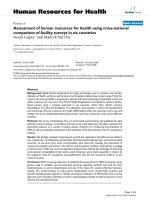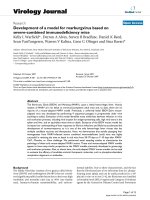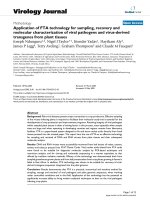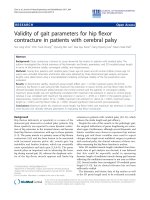Báo cáo sinh học: " Estimation of genetic parameters for body weight traits in squab pigeons" pdf
Bạn đang xem bản rút gọn của tài liệu. Xem và tải ngay bản đầy đủ của tài liệu tại đây (356.54 KB, 7 trang )
Original
article
Estimation
of
genetic
parameters
for
body
weight
traits
in
squab
pigeons
SE
Aggrey,
KM
Cheng
University
of British
Columbia,
Department
of
Animal
Science,
Avian
Genetics
Laboratory,
Vancouver,
BC
Canada
V6T
lZ4
(Received
27
September
1991;
accepted
1st
September
1992)
Summary -
Seven
hundred
and
two
squabs
(young
pigeons)
from
144
pairs
of
Silver
King
x
White
King
cross
parents
were
reared
by
either
their
genetic
or
foster
parents.
Heritabilities
were
estimated
for
body
weight
at
hatch,
3d,
1
wk,
2
wk,
3
wk
and
4
wk
(market
age)
of
age
and
the
values
were
0.70, 0.23,
0.22,
0.21,
0.30
and
0.57,
respectively.
Genetic
correlations
among
these
body
weight
traits
ranged
from
0.26
to
0.82.
Heritability
estimates
for
weekly
gains
were
0.13,
0.00,
0.12
and
0.05.
These
estimates
indicated
that
simultaneous
genetic
improvement
of
body
weight
at
the
different
ages
would
be
feasible.
Production
efficiency
could
be
increased
through
selection
to
improve
wk
3
body
weight
so
that
squabs
could
be
marketed
a
week
earlier
than
the
current
practice.
pigeon
/
heritability
/
genetic
correlations
/
body
weight
/
weight
gain
Résumé -
Estimation
des
paramètres
génétiques
pour
des
caractères
de
poids
corporel
chez
le
pigeonneau.
Un
total
de
702
pigeonneaux
obtenus
à
partir
de
croisements
entre
1/4
couples
Silver
King
et
White
King
ont
été
élevés
par
leurs
parents
génétiques
ou
par
des
parents
adoptifs.
Les
valeurs
d’héritabilité
ont
été
estimées
pour
le
poids
corporel
à
différents
âges:
à la
naissarece;
3 jours;
1
semaine;
2
semaines;
3
semaines;
et
4
semaines
(âge
à
la
mise
sur
le
marché).
Les
estimées
sont
respectivement:
0,70,
0,23,
0,22,
0,21,
0,30, et
0,57.
Les
corrélations
génétiques
entre
ces
mesures
du
poids
corporel
varient
entre
0,26
et
0,82.
Les
héritabilités
estimées
pour
les
gains
de
poids
hebdomadaires
sont
0,13,
0,00,
0,12
et
0, 05.
Ces
résultats
indiquent
que
des
améliorations
génétiques
simultanées
du
poids
corporel
à
difJ’érents
âges
sont
possibles.
Une
augmentation
de
l’efficacité
de
production
pourrait
être
obtenue
par
sélection
afin
d’améliorer
le
poids
corporel
à
3
semaines,
ce
qui
permettrait
de
diminuer
d’une
semaine
l’âge
auquel
les
pigeonneaux
peuvent
être
vendus
sur
le
marché.
pigeonneau
/ héritabilité
/ corrélation
génétique
/ poids
corporel
gain
de
poids
*
Correspondence
and
reprints
INTRODUCTION
Pigeons
are
widely
used
as
experimental
models
in
biomedical
research
and
have
also
been
raised
for
meat
production.
Commercial
squab
(young
pigeon)
production
has
existed
in
North
America
since
the
early
1900s
(Levi,
1974;
Stanhope,
1978)
and
annual
production
is
over
one
and
half
million
squabs
in
the
United
States
and
Canada
(Cheng,
1986).
Unlike
other
poultry
species,
pigeons
form
pair
bonds
to
breed
and
hatchlings
must
be
brooded
and
fed
by
their
parents
until
the
market
age
of
4
wk
(Levi,
1974).
A
pair
of
pigeons
can
raise
about
15
squabs
per
year.
Although
meat
from
squabs
is
produced
commercially,
information
regarding
breeding
techniques
and
advances
is
lacking.
No
concentrated
effort
in
selection
to
improve
the
efficiency
of
production
(in
terms
of
the
number
of
squabs
produced
by
a
breeding
pair)
has
been
made
since
Australia’s
Squab
Production
Tests
of
the
early
1930s
(Dark,
1973).
Cheng
and
Yelland
(1988)
provided
the
first
heritability
estimates
for
squab
body
weights
at
different
ages
using
variance
components
and
regression
analysis.
Their
data
suggested
that
parental
and
seasonal
factors
affected
squab
body
weight,
but
they
neither
corrected
their
estimates
for
seasonal
and
other
environmental
factors
nor
estimated
genetic
correlations
among
the
traits.
In
the
present
study
(reported
on
briefly
by
Aggregy
and
Cheng,
1991),
we
used
the
same
pigeon
population
of
Cheng
and
Yelland
(1988).
In
an
attempt
to
separate
the
environmental
effect
of
the
parents
from
the
additive
genetic
variance,
a
cross-fostering
scheme
was
carried
out
to
estimate
heritabilities
and
correlations
of
body
weight
traits
in
squabs
from
hatch
till
4
wk
of
age.
MATERIALS
AND
METHODS
The
squabs
used
in
this
study
were
the
progeny
of
White
King
by
Silver
King
cross
parents.
Such
a
cross
was
made
in
an
attempt
to
develop
an
autosexing
system
(Cheng,
1986).
Silver
and
White
Kings
are
2
strains
of
the
same
breed,
differing
in
only
a
few
loci
that
affect
plumage
colour,
and
both
have
similar
performances
and
selection
policy
under
the
standards
established
by
The
American
King
Club
(Levi,
1974;
PJ
Marini,
Nicholas
Breeding
Farms,
Sonoma,
CA,
USA;
personal
communication).
Our
F2
performance
data
can
therefore
be
treated
as
providing
estimates
of
purebred
parameters.
There
were
144
pairs
of
breeders.
Each
pair
of
breeders
were
housed
in
a
61
cm
x
61
cm
x
46
cm
wire
cage
provide
with
2
nests.
They
were
fed
ad
libitum
on
a
commercial
pelleted
diet
containing
17%
protein
and
added
crushed
oyster
shells.
Eggs
were
taken
away
from
the
parents
after
a
complete
clutch
(2
eggs)
was
laid
and
replaced
with
wooden
dummy
eggs
for
the
parents
to
complete
incubation.
Eggs
were
hatched
artificially
throughout
the
year
and
newly
hatched
squabs
were
placed
either
under
their
own
parents
or
with
foster
parents
at
the
same
stage
of
incubation.
The
squabs
were
weighed
at
hatch,
3
d,
1
wk,
2
wk,
3
wk
and
4
wk
post-hatch.
Data
on
progenies
from
different
clutches
of
the
same
parents
were
used
and
corrected
for
various
fixed
effects.
Statistical
analysis
The
data
were
analyzed
according
to
the
following
model:
where
Y2!!1&dquo;,,
is
the
weight
or
weight
gain
(g)
of
the
7ath
progeny
in
the
ijklh
class;
IL
is
the
overall
mean;
ai
is
the
random
effect
of
the
ith
mating
pair;
F!
is
the
fixed
effect
of
the
jth
foster
parent;
Bk
is
the
fixed
effect
of
the
kth
clutch;
Sl
is
the
fixed
effect
of
the
lth
season
in
which
the
squab
was
hatched;
E!!kvm
is
the
random
error.
Variance
components
were
estimated
using
the
variance
component
procedure
(PROC
VARCOMP)
of
the
SAS
Institute
(1985)
computer
package.
Heritabilities
(h
2)
were
estimated
by:
where
(1!
is
the
between
matings
variance
component
and
ol
is
the
phenotypic
variance
component.
Progeny
from
mating
pairs
are
full
sibs.
The
between
mating
pair
component
((1!)
includes
the
variance
due
to
genetic
differences
in
body
weight
or
weight
gain
among
full
sibs
50%
of
the
additive
genetic
variance
and
25%
of
the
dominance
genetic
variance)
(Cockerham,
1954).
In
addition,
this
component
includes
the
variance
resulting
from
the
influence
of
preoviposition
environment
provided
to
the
fertilized
egg
by
the
dam.
Much
of
such
influence
can
be
classified
as
genetic
with
regard
to
the
dam,
but
is
classified
as
environmental
from
the
standpoint
of
the
young
squab.
Standard
errors
(SE)
of
the
h2
were
estimated
by:
as
indicated
by
Becker
(1984),
where n
is
the
total
number
of
individuals;
t is
the
intraclass
correlation;
k
is
the
coefficient
of
the
between
matings
variance
component
and
s
is
the
number
of
matings.
Correlations
(r
x
y)
were
estimated
by:
where
r!y
is
the
estimate
of
genetic
or
phenotypic
correlation;
Cov(x, y)
is
the
genetic
or
phenotypic
covariance
between
traits x
and
y,
and
var(x)
and
var(y)
are
the
estimated
genetic
or
phenotypic
variances
of
traits
x
and
y,
respectively.
Standard
errors
for
genetic
correlations
(rg)
were
calculated
by
an
approximation
formula
given
by
Robertson
(1959).
where
rg
is
the
genetic
correlation
between
traits x
and
y.
RESULTS
Morphological
techniques
for
sexing
squabs
are
not
reliable
so
the
body
weights
and
weight
gains
reported
are
not
differentiated
by
sex.
Overall
means,
phenotypic
standard
deviations
(up)
and
heritability
estimates
of
body
weight
and
weight
gain
at
different
ages
are
presented
in
table
1.
Variability
in
body
weight
is
!
12%
on
day
of
hatch
and
increases
to
32%
at
3
d
of
age,
it
then
declines
gradually
to !
11%
at
4
wk
of
age.
Variability
in
weight
gain
during
the
1st
wk
is
!
28%,
declines
to
?
19%
at
wk
2,
and
then
increases
to x5
40%
at
wk
3.
The
weight
gain
from
3-4
wk
is
not
significantly
different
from
0.
The
heritability
estimates
for
body
weights
were
generally
higher
than
estimates
for
weight
gains.
The
genetic
and
phenotypic
correlations
estimated
from
the
full
sib
components
of
variance
for
body
weights
and
weight
gains
are
presented
in
tables
II
and
III
respectively.
Genetic
correlations
among
the
body
weight
traits
range
from
0.26
to
0.80.
Phenotypic
correlations
between
hatch
weight
and
later
body
weight
were
all
low
and
rp
among
body
weight
traits
from
3
d
of
age
till
4
wk
ranged
from
0.38
to
0.89.
Both
phenotypic
and
genetic
correlations
among
the
different
weight
gains
were
either
zero or
negative
ranging
from
-0.23
to
-0.49.
DISCUSSION
The
hatching
weight
of
squabs
was
relatively
constant
with
a
high
heritability
probably
due
to
the
common
preovipositional
maternal
variance
(egg
size).
The
heritability
estimate
for
body
weight
at
3
wk
was
similar
to
the
estimate
reported
by
Cheng
and
Yelland
(1988).
However
heritability
estimates
for
body
weight
at
3
d,
1
wk,
and
2
wk
of
age
were
higher
(0.23,
0.22
and
0.21
compared
to
0.14,
0.04
and
0.16),
and
estimates
for
body
weight
at
hatch
and
4
wk
were
lower
(0.70
and
0.57
compared
to
0.74
and
0.65)
than
those
calculated
by
Cheng
and
Yelland
(1988)
using
full
sib
variance
components.
Cheng
and
Yelland
(1988)
reported
that
heritabilities
estimated
by
regression
(progeny
on
mid-parent)
for
squab
weights
to
1
wk
were
zero
but
after
1
wk
of
age
their
values
estimated
from
regression
and
from
full
sib
components
were
similar.
Heritabilities
estimated
from
covariance
of
full
sibs
are
biased
by
one
quarter
of
the
dominance
variance
and
the
common
environmental
variance.
Hatchlings
from
precocial
species
such
as
chickens
can
be
reared
independently
of
the
parents,
but
the
young
of
pigeons
(altricial)
are
dependent
on
their
parents,
causing
resemblance
of
full
sibs.
The
cross
fostering
experiment
was
designed
to
minimize
the
bias
of
the
full
sib
covariance
caused
by
common
nest
environment
and
post-hatch
parental
effects.
Pigeons
form
pair
bonds,
so
that
designing
a
mating
system
to
provide
substantial
numbers
of
half
sibs
to
estimate
heritability
from
the
sire
component
of
variance
is
difficult.
It
is
not
possible
under
the
present
model
to
divide
the
11!
into
additive
genetic
variance,
dominance
genetic
variance
and
variance
due
to
preoviposition
environment.
On
the
other
hand,
in
broiler
chicks,
Pinchasov
(1991)
reported
that
the
high
initial
correlation
between
egg
weight
and
chick
weight
decreased
markedly
after
hatch
and
was
not
significant
by
5
d
after
hatching.
Similarly,
as
the
age
of
the
squab
increases,
the
preovipositional
maternal
effect
on
body
weight
may
become
insignificant
compared
to
the
effect
of
the
genotype.
Additive
genetic
variances associated
with
body
weight
from
3
d
of
age
to
2
wk
were
low,
indicating
that
the
rp
between
body
weight
traits
until
2
wk
resulted
primarily
from
environmental
causes.
The
parental
ability
to
raise
squabs
for
the
first
2
wk
is
vital.
Breeding
pigeons
are
more
sensitive
to
environmental
changes
than
chickens
(Cheng,
personal
observation),
so
disturbances
during
the
first
2
wk
of
brooding
should
be
kept
to
a
minimum.
Selection
to
improve
parenting
traits,
if
these
traits
are
heritable,
should
be
important
and
their
genetic
correlations
with
squab
growth
should
be
examined.
After
2
wk
of
age,
additive
genetic
variance
was
associated
with
body
weight
increases,
indicating
that
after
this
age
the
body
weight
of
squabs
is
influenced
by
their
own
genotype.
Genetic
correlations
are
important
for
determining
the
genetic
relationship
between
body
weights
at
different
ages.
Estimates
of
r9
between
weight
at
hatch
and
weight
at
ages
2-4
wk
were
low
and
suggest
that
squab
hatch
weight
is
a
poor
indicator
of
later
body
weight.
As
pointed
out
by
Abdellatif
(1989),
hatch
weight
must
therefore
be
considered
a
separate
trait.
The
relatively
high
heritability
for
4
wk
body
weight,
low
heritabilities
for
weight
at
other
ages,
and
the
low
or
negative
genetic
correlations
among
weight
gains
for
different
periods
could
indicate
that
squabs
are
opportunistic
growers
having
the
genetic
potential
to
make
compensatory
gains
whenever
conditions
are
favourable.
The
relatively
higher
heritabilities
of
body
weights
late
in
this
trial
indicate
that
genetic
gains
could
be
made
through
selection
allowing
squabs
to
reach
market
weight
earlier
than
4
wk,
which
would
shorten
the
recycling
time
for
parents.
ACKNOWLEDGMENTS
The
experiment
was
funded
by
a
Science
Council
of British
Columbia
Operating
Grant,
BCASCC
Agricultural
Research
and
Development
Fund,
Nanaimo
Poultry
Processors,
and
VIM
Squab
Farm.
We
thank
G
Yelland
for
technical
assistance
and
PJ
Marini,
WF
Hollander
and
anonymous
reviewers
for
their
helpful
suggestions.
REFERENCES
Abdellatif
MA
(1989)
Genetic
study
of
Dandarawy
chicken:
I.
Heritabilities
and
genetic
correlations
of
body
weight
and
weight
gain.
Genet
Sel
Evol 21,
81-92
Aggrey
SE,
Cheng
KM
(1991)
Heritability
estimates
and
genetic
correlations
for
body
weight
traits
in
squab
pigeons.
Poult
Sci
70,
(suppl 1),
2
Becker
WA
(1984)
Manual
of
Quantitative
Genetics.
Academic
Enterprises,
Pull-
man,
Washington,
4th
edn
Cheng
K1!I
(1986)
UBC
search
for
squab
production
efficiency.
Country
Life
(June)
p A6
Cheng
KNl,
Yelland
G
(1988)
Factors
affecting
squab
body
weight
and
the
number
of
squabs
produced
in
a
year.
In:
Proc
18th
World’s
Poult
Congr.
Nagoya,
Japan,
586-587
Cockerham
CC
(1954)
An
extension
of
the
concept
of
partitioning
hereditary
variance
for
analysis
of
covariance
among
relatives
when
epistasis
is
present.
Genetics
39,
859-882
Dark
J
(1973)
There’s
room
for
improvement
of
local
table
pigeon.
J
Avicult
(Aust)
71, 447-449
Levi
VM
(1974)
The
Pigeon.
Levi
Publ
Co
Inc,
Sumter,
SC
Pinchasov
Y
(1991)
Relationship
between
the
weight
of
hatching
eggs
and
subse-
quent
early
performance
of
broiler
chicks.
Br
Poult
Sci
32,
109-115
Robertson
A
(1959)
The
sampling
variance
of
the
genetic
correlation
coefficients.
Biometrics
15,
569-485
SAS
Inst
Inc
(1985)
SAS
User’s
Guide:
Statistics.
SAS
Institute
Inc,
Cary,
NC,
version
5
edn
Stanhope
B
(1978)
The
species
(guinea
fowl,
pheasant,
quail
and
squab
pigeon)
our
ancestors
forgot.
J
Agric-Melb
76
(7),
250-251

